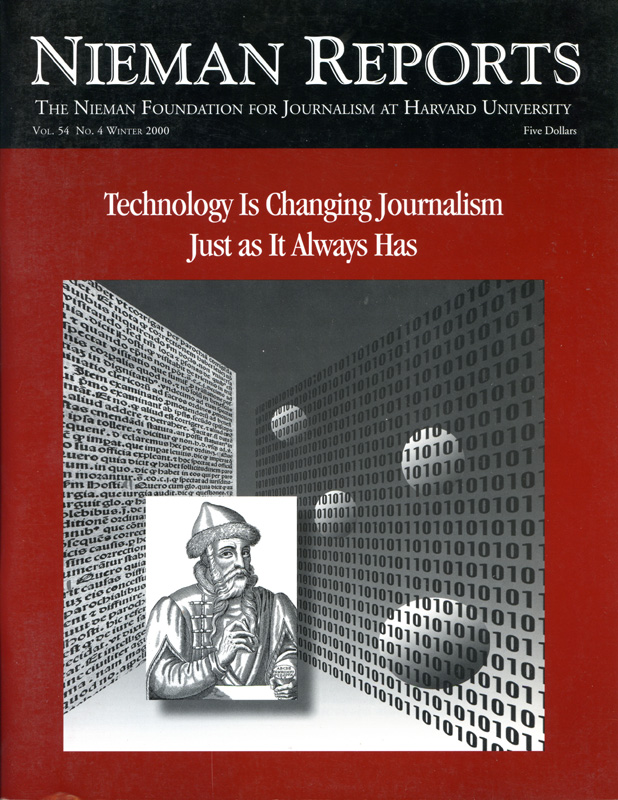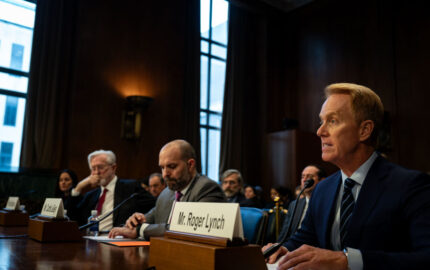
Technology Is Changing Journalism Just as It Always Has
Our journey into the digital future begins with an essay by Tom Regan, associate editor of The Christian Science Monitor’s Web site. His advice: Remember that technology is changing journalism, “as it always has;” wireless is the next publishing realm, and the Web—as a news distribution method—is (almost) already dead.
"Amid all of this technological razzle-dazzle, one thing remains the same,” observed Jens-Kristian Søgaard, renowned picture editor at Denmark’s largest daily newspaper, Morgenavisen Jyllands-Posten. “We must maintain our high ethical standards, mustn’t we?”
As the 21st century dawns, it is fashionable to join in on the great debate about how to maintain the integrity and value of still photography as computer imaging tries to crowd it out in photojournalism. In fact, many contributors to critical thinking circles from the camps of reflective practitioners and practical scholars choose to write off the still photograph, declaring that its time is past. But I argue that now is not the time to write off such a meaningful form of communication.
For Mr. Søgaard and 16 of his colleagues representing Denmark, a country of five million people that until recently was known primarily for its fine quality furniture and craftsmanship, times are changing, too. This select delegation made up of photojournalists (photographers, editors and one Web producer) journeyed to St. Petersburg Beach, Florida, to study convergence in photojournalism in a seminar entitled, “Technology provides new possibilities and new challenges to photographers.”
In recent international photojournalism competitions, the Danes have done very well. And I know a bit about Denmark’s journalism culture, having traveled there to teach and consult, by working with numerous visual journalists from this high quality-minded country, and studying the recent works of fine Danish photographers such as Claus Bjørn Larsen, Bo Svane and Tine Harden. Right now, however, Danish newspapers are losing money. Their high standards, short work week, generous wages and production costs are to blame, according to Søgaard. “Indeed we are accustomed to working with the best materials,” he says.
When this Danish delegation arrived in central Florida, they found themselves in a region of our country that is a hotbed of convergence experimentation. The Danes visited three leaders in media convergence—the Sarasota Herald Tribune, the Orlando Sentinel, and the Tampa Tribune. Each of these organizations is jointly producing news coverage for a daily print publication, a 24-hour broadcast cycle, and a minute-to-minute Web site.
The Media General NewsCenter in Tampa, Florida offers a contemporary glimpse at what much of journalism might operate like during the 21st century. As one might expect, we saw many reporters loaded up with all different kinds of digital equipment. And this view unfolded in front of us with tour guides and translators speaking Romanian, Swedish, Danish, Norwegian, Japanese and Chinese, all in the same day, as various journalism groups toured the site.
In fact, photojournalists from around the world are keeping a watchful eye on the ways in which this organization is refining its focus and recreating the medium of photographic storytelling.
Dirck Halstead, Time’s former White House photographer and founder of the Digital Journalist Web Site is often associated with photojournalism’s epitaph: “Photojournalism, as we know it, is dead.” Halstead’s position is rooted in the technical changes in camera capture systems and the movement toward full-motion video. Another view, held by Colin Jacobson, former magazine picture editor in the United Kingdom and instructor at Cardiff University School of Journalism, argues that what photojournalism needs instead is renewal and reinvention. “It’s not the spirit of photojournalist that is at fault here, but their lack of desire to renew and reinvent the medium,” Jacobson wrote in the introduction of the book, “The Best of Photojournalism 2000.”
The voices of Søgaard, Halstead, Jacobson and countless visual journalists seeking to preserve the ever-important craft of photographic storytelling all have something to contribute to critical discussion about photojournalism’s future. To ensure that photographic storytelling remains a vital and respected form of communication, I believe that four aspects of it must be made priorities. Without urgent attention being paid, the medium is doomed.
Let me state this even more bluntly. For American photojournalists, film is dead. But photography, as a vital form of communication, is alive, and it needs to be nurtured. Of course, photojournalism is evolving during these ever-changing digital times. We live in a time of instantaneous transmission of visual imagery. Digital cameras, Adobe System’s image management software program PhotoShop, and advance telecommunications devices like satellite dishes and digital cell phones make the world a very different place in which to produce journalism. The possibilities of digital delivery of images are limitless.
Photojournalists can learn a lot from the Danish approach. After a week of studying and measuring and fact-finding, the Danish team returned to their country with the intent of advancing and refining the quality of photographic storytelling, sharpening the focus of their work and recreating their approach.
In the wise words of historian Eric Hoffer, “In times of change…learners inherit the earth and the learned are wonderfully prepared for a world that no longer exists.”
Kenny Irby is visual journalism group leader at The Poynter Institute for Media Studies, where he teaches seminars and consults in areas of photojournalism, leadership, ethics and managing diversity. While a photo editor at Newsday, he contributed to three Pulitzer Prize-winning projects and was a photographer, picture editor, and deputy of photography.
As the 21st century dawns, it is fashionable to join in on the great debate about how to maintain the integrity and value of still photography as computer imaging tries to crowd it out in photojournalism. In fact, many contributors to critical thinking circles from the camps of reflective practitioners and practical scholars choose to write off the still photograph, declaring that its time is past. But I argue that now is not the time to write off such a meaningful form of communication.
For Mr. Søgaard and 16 of his colleagues representing Denmark, a country of five million people that until recently was known primarily for its fine quality furniture and craftsmanship, times are changing, too. This select delegation made up of photojournalists (photographers, editors and one Web producer) journeyed to St. Petersburg Beach, Florida, to study convergence in photojournalism in a seminar entitled, “Technology provides new possibilities and new challenges to photographers.”
In recent international photojournalism competitions, the Danes have done very well. And I know a bit about Denmark’s journalism culture, having traveled there to teach and consult, by working with numerous visual journalists from this high quality-minded country, and studying the recent works of fine Danish photographers such as Claus Bjørn Larsen, Bo Svane and Tine Harden. Right now, however, Danish newspapers are losing money. Their high standards, short work week, generous wages and production costs are to blame, according to Søgaard. “Indeed we are accustomed to working with the best materials,” he says.
When this Danish delegation arrived in central Florida, they found themselves in a region of our country that is a hotbed of convergence experimentation. The Danes visited three leaders in media convergence—the Sarasota Herald Tribune, the Orlando Sentinel, and the Tampa Tribune. Each of these organizations is jointly producing news coverage for a daily print publication, a 24-hour broadcast cycle, and a minute-to-minute Web site.
The Media General NewsCenter in Tampa, Florida offers a contemporary glimpse at what much of journalism might operate like during the 21st century. As one might expect, we saw many reporters loaded up with all different kinds of digital equipment. And this view unfolded in front of us with tour guides and translators speaking Romanian, Swedish, Danish, Norwegian, Japanese and Chinese, all in the same day, as various journalism groups toured the site.
In fact, photojournalists from around the world are keeping a watchful eye on the ways in which this organization is refining its focus and recreating the medium of photographic storytelling.
Dirck Halstead, Time’s former White House photographer and founder of the Digital Journalist Web Site is often associated with photojournalism’s epitaph: “Photojournalism, as we know it, is dead.” Halstead’s position is rooted in the technical changes in camera capture systems and the movement toward full-motion video. Another view, held by Colin Jacobson, former magazine picture editor in the United Kingdom and instructor at Cardiff University School of Journalism, argues that what photojournalism needs instead is renewal and reinvention. “It’s not the spirit of photojournalist that is at fault here, but their lack of desire to renew and reinvent the medium,” Jacobson wrote in the introduction of the book, “The Best of Photojournalism 2000.”
The voices of Søgaard, Halstead, Jacobson and countless visual journalists seeking to preserve the ever-important craft of photographic storytelling all have something to contribute to critical discussion about photojournalism’s future. To ensure that photographic storytelling remains a vital and respected form of communication, I believe that four aspects of it must be made priorities. Without urgent attention being paid, the medium is doomed.
- Content is key. Photojournalists as well as their publications must strive to produce and publish photographic reportage that is compelling and meaningful. No longer should the aesthetic value supercede the journalistic value. Journalistic photographs, captured by courageous men and women who document life’s visages—from the pedestrian to the extreme—deserve the right to be seen far more than do decorative page fillers or dressing material.
- An ethic of integrity is essential. Honesty and accuracy must remain the watermark of every image, along with the need for balance to be observed in our coverage. Balance serves as a great reminder that there are often multiple truths to be reported in our visual storytelling. Photojournalists must hold fast to the purpose of informing the world about life’s wide array of facets and encounters, but always with the intent to inform rather than to deceive and to help rather than to harm. Therefore, the photographer’s quest need be one of the conscious observer who has thought through his or her journalistic purpose in advance, rather than acting like a pesky insect on the wall.
- Learners have an inheritance. In this era of swift technological advances, “technophobia” is a posture of ruin. Photojournalists must harness the powers of change and use them to find ways to improve the quality of still photojournalism, extend their storytelling skills, and preserve the archival value of edited images for present and future use. There is a tremendous need to be able to reacquire previously unpublished images. Somewhere in this great debate about technology, we must acknowledge the harsh reality that readers and viewers are aware of the power of graphic software applications to alter images. I believe that readers/viewers are more concerned about the value of accurate information in a photograph than they are about the technical system by which images are stored, such as on a strip of film or a digital pc-card.
- Diversity is a process, rather than an experience. We live in an ever-changing world that is condensed by the vastness of the Internet and the speed of telecommunications. As Americans, we think nothing of traveling to far-flung regions of the globe and expect that photographers will deliver images that vicariously take us to places that we never see and seldom hear about. Increasingly, as journalists, we are more thoughtful about in what direction we point the camera and when do we worry that our images might reinforce stereotypes. Yet we should also recognize that we have many miles to go before all of America is involved in the storytelling about America. Therefore, as we seek to understand the world around us through photographs, we must refine our focus. Think of photographs that have attempted to capture the essence of, for example, a Broward County supervisor examining a “chad” left on a ballot to determine a voter’s intent. Or the photograph showing little four-month-old Miracle Jackson’s body, found in a plastic bag, being removed from the crime scene. Or the ability we had to witness the triumphant expression on a gold medal-winning athlete’s face. Or the debate that ensued after a photograph showed the terror felt by Elian Gonzalez as Immigration and Naturalization Service agents with weapons rushed into his relatives’ Little Havana home to seize him. Or when we peered into faces of those living in the Balkans, a place where there were so many heartwrenching images of victims of senseless violence in Kosovo and beyond. It is time now to strengthen photojournalism and ensure its credibility. We do this by holding true to our ethical responsibilities as journalists, while also embracing changes made possible by technological innovation. “The ethical issues are as real today as they were when I started in this business,” says Alan Diaz, the Miami-based Associated Press photographer who captured Elian’s terror.
Let me state this even more bluntly. For American photojournalists, film is dead. But photography, as a vital form of communication, is alive, and it needs to be nurtured. Of course, photojournalism is evolving during these ever-changing digital times. We live in a time of instantaneous transmission of visual imagery. Digital cameras, Adobe System’s image management software program PhotoShop, and advance telecommunications devices like satellite dishes and digital cell phones make the world a very different place in which to produce journalism. The possibilities of digital delivery of images are limitless.
Photojournalists can learn a lot from the Danish approach. After a week of studying and measuring and fact-finding, the Danish team returned to their country with the intent of advancing and refining the quality of photographic storytelling, sharpening the focus of their work and recreating their approach.
In the wise words of historian Eric Hoffer, “In times of change…learners inherit the earth and the learned are wonderfully prepared for a world that no longer exists.”
Kenny Irby is visual journalism group leader at The Poynter Institute for Media Studies, where he teaches seminars and consults in areas of photojournalism, leadership, ethics and managing diversity. While a photo editor at Newsday, he contributed to three Pulitzer Prize-winning projects and was a photographer, picture editor, and deputy of photography.


